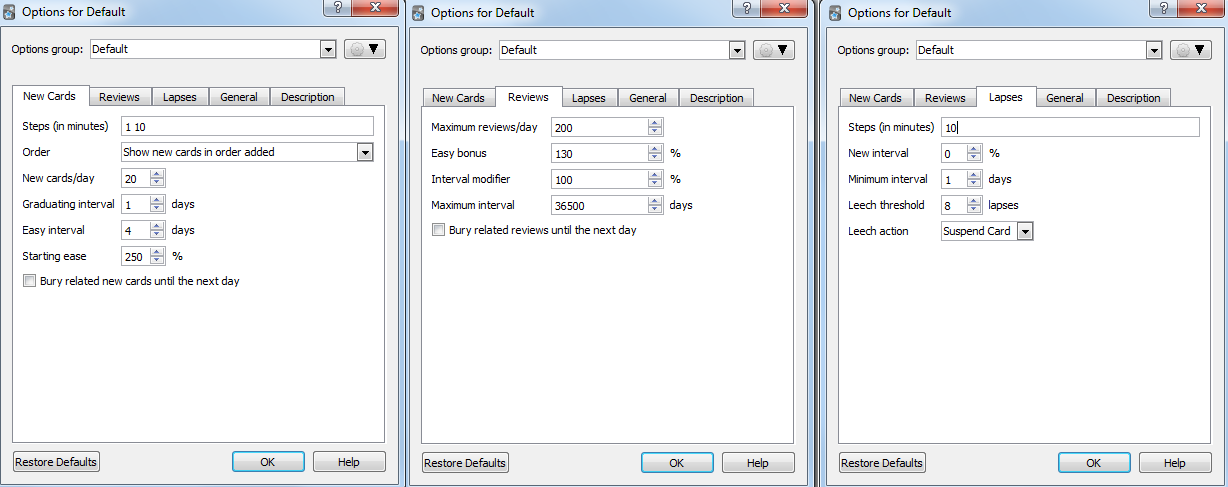My BIGGEST Discovery From Tweaking the Anki Setting

Photo by Krissana Porto on Unsplash
This is the default Anki’s setting:

From Anki’s Manual:
New interval controls how much Anki should reduce the previous interval by. If the card had a 100 day interval, the default of 0% would reduce the interval to 0
In the default Anki setting, if you get a card wrong, the New Interval for lapses would render it new again, like you’ve never seen or learned that card.
For example, you have answered a card correctly (pressed ‘Easy’) for 10 times over 3 years. If you then fail it ONCE (pressed ‘Again’), Anki would banish the card back to square one. I discovered this brutal New Interval setting only after 4 years of using Anki.
There are a lot of factors affecting your retrieval strength, i.e., recalling the correct answer. Contextual cues, including environmental, mood state, body state cues etc, will influence the accessibility of a memory representation. So you may be tired after doing Anki for 4 hours and that body state will negatively affect your ability to retrieve the answer; maybe you could have answered that card at 10 a.m. when you were most alert; maybe you could have answered it if you’d just racked your brains a little harder.
From “Self-Regulated Learning: Beliefs, Techniques, and Illusions":
Once information is interrelated with prior knowledge in long-term memory, it tends to remain stored, if not necessarily accessible.
My point is, just because you temporarily couldn’t retrieve the information doesn’t mean you have to re-learn it, treating it like you’ve not learned it at all because that piece of memory is still in your long-term memory. Losing retrieval strength ≠ losing storage strength.
For example, you’ve changed your phone number after using the old one for years. If you’ve used the new number long enough, you’re bound to “forget” the old number (retrieval-induced forgetting). But do you think you need the same amount of time memorizing the old number when you need it, like you have never seen it? Of course not! Maybe just a few initial numbers are enough to jog your memory and you’ll spill out the rest.
Inefficient Default Anki Setting
The default setting is highly inefficient as having to start over is completely unnecessary. Just a one-time corrective feedback for that card should probably make it retrievable again for a long time (years maybe). Having to review it over and over again leads to a lot of frustration. You will mostly likely continue to struggle with the review count. Imagine the pain of reviewing a card correctly for years and then slipped for once… all the previous effort to expand the retrieval schedules. Puff. Gone. It’s like repetitively building a sand castle only to be washed away moments later.
I wonder how many users are still using that brutal default setting… I am sure a lot of people never bothered to tweak the settings, not to mention reading the manual to understand what each parameter means and how it affects the algorithm. I think once people know how the default setting behaves, they would tweak it immediately.
Now you know. If you’re using Anki, I highly recommend tweaking the default setting. I also recommend you give this part of the Anki manual a look before any changes.
Regardless how you tweak other parameters, one thing I’m certain of is that the New Interval for lapses COULDN’T AND SHOULDN’T BE ZERO. I would suggest setting it over 40%. As I explained, it doesn’t make sense to banish the card and re-learn it completely again.
If memory serves, I mostly followed the recommendation from this and this. Most of my decks are more or less the same with the following Anki setting:
|
|
Please see this reddit post for the rationales behind such setting. I do not recommend you directly copying my setting. First, there were still a lot of guesses and “personal experience”. There is essentially no feedback no matter how you change the settings. For example, I’ve added one more Step 14400. What effect might this have? Well, I know that I will need to grade that card correctly one more time before it will be graduated to become a review card. Also, I’ve stretched the learning step 10 days more which makes learning cards harder to graduate and become review cards.
I know what effects changing a particular parameter have, but I have no idea how it affects the learning effectiveness and efficiency. My rationale for adding more Steps is that, the weaker the retrieval strength (which is true for new cards), the more reviews it requires. But is this true? As I have mentioned in why I switched to SuperMemo, the relationship between retrieval strength and storage strength is a peculiar and unintuitive one. This is one reason why I switched to SuperMemo: I had no idea how to tweak the Anki setting parameters; in SuperMemo, I have next to no control over the algorithm.
With my setting, I may have completely broken the normal behaviors of the algorithm and ended up dramatically reducing the effectiveness and efficiency of it. Or just the opposite. I don’t know. So follow and play with it with discretion.
If you want to play it safe, just change the the New Interval for lapses to 40% and you’re probably fine.